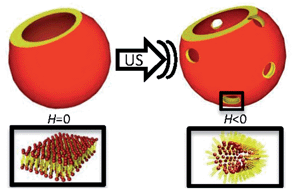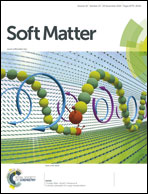Role of lipid polymorphism in acoustically sensitive liposomes
Abstract
Ultrasound (US) triggered drug release is a promising drug delivery method that allows ex vivo modulation of treatment intensity and duration. This method relies on the synergistic interaction between the rupture of sonosensitive particles and enhanced plasma membrane permeability. Conventional liposomal systems where the drug passively diffuses through the membrane show virtually no response to acoustic energy. One method to activate drug transport is to induce a topological restructuring of the lipid membrane (zero intrinsic curvature, H = 0) by puncturing pores (H < 0) through which the drug can readily leak out from the interior of the liposomes. In this work we demonstrate strategies to lower the energy cost of creating such membrane defects by introducing lipid molecules with molecular shapes prone to self-assemble into non-lamellar (negative intrinsic curvature, H < 0) structures. All formulations investigated comprise the relevant components typically required for delivery applications such as stealth moieties, cholesterol, and phospholipids. Small angle X-ray scattering studies of a number of lipid systems at increasing amounts of phosphatidylethanolamine (PE) phospholipids reveal that membranes without PE respond to ultrasound by thinning ca. 10 Å, which concomitantly lowers the bending rigidity quadratically in addition to increasing the passive drug permeability. However, at the appropriate PE content the lipid systems display a classic lamellar structure (H = 0) that undergoes a topological transformation after ultrasound exposure into lipid tubes of the reversed type (H < 0) packed in a 2D hexagonal array. At the dilute regime, Fluorescence Microscopy of giant unilamellar vesicles (GUVs) comprising DOPE also experience ultrasound induced restructuring that can be modulated by DOPE content. In general, smaller vesicles of diverse shape connect and form into a “pearl-necklace” configuration. We argue that the inclusion of DOPE within the GUV membrane may result in curvature-driven lipid sorting, providing the system with local membrane instabilities that drive vesicle pearling when exposed to ultrasound.


 Please wait while we load your content...
Please wait while we load your content...